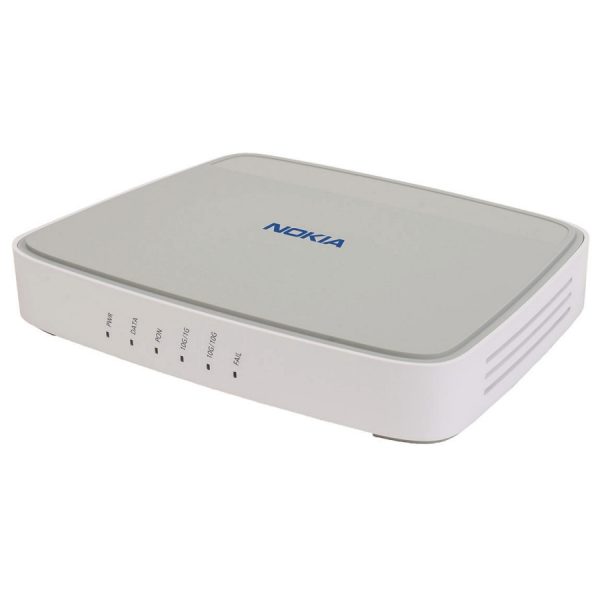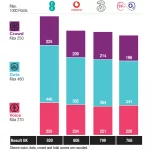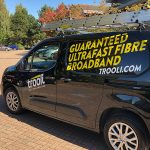Openreach Adopts Nokia’s 10Gbps FTTP Broadband Kit for UK UPDATE

Openreach (BT) has today expanded their supplier agreement with Finnish telecoms giant Nokia to include GPON and XGS-PON based fibre access technologies, which will support their UK roll-out of Fibre-to-the-Premises (FTTP) based broadband ISP technology and make 10Gbps symmetrical speeds possible in the “future.”
At present Openreach’s “full fibre” network already covers 2.6 million UK homes and businesses (rising to 4.5 million by March 2021) and they’ve recently proposed to invest £12bn in order to reach a total of around 20 million homes and businesses by the “mid – to late-2020s” (here).
Most of the kit for their existing FTTP network has come from Chinese firm Huawei, with some older infrastructure also coming from ECI. On top of that they’ve recently selected ADTRAN‘s Software-Defined (SD) Fibre Access Platform to help support their deployment plans (here), which included their SDX Series of Optical Line Terminals (OLTs) and the Mosaic Cloud Platform.
Advertisement
The new deal with Nokia is intended to complement all that. As part of this deal Openreach will look to deploy the Finnish firms own fibre access solution, which includes the 7360 Intelligent Service Access Manager (ISMA) FX, 7362 ISAM DF and the ISAM ONTs (Optical Network Terminals – these are usually found inside your home on the wall, pictured top).
We don’t know exactly which model of Nokia ONT Openreach will be using, although their current standard 7368 unit (pictured) has a clever twist. The device includes ONTs with a VDSL2 or G.Fast port, which means the ONT can “reuse the last meters of copper eliminating the cost of installing fibre in the home” (potentially a cost saving but FTTdp solutions can be tricky).
Nokia’s solution also supports a smooth evolution from current traditional deployments to virtualized access-network control and management (SDAN – Software Defined Access Networking) by software upgrade.
Clive Selley, CEO of Openreach, said:
“We’re accelerating our full fibre build to deliver an ultrafast, ultra-reliable and futureproof broadband network throughout the UK. This new digital platform will help our economy to bounce back more quickly from the Covid-19 pandemic – enabling people to continue work from home, and millions of businesses to operate seamlessly online for decades to come. Right now, we’re making the new network available to around 32,000 homes and businesses every week, and Nokia’s innovative solutions are helping us to build it better, broader and faster. Our partnership with Nokia will be critical in helping us to upgrade the nation and hit our target of reaching four and a half million premises by the end of March 2021.”
Sandra Motley, President of Fixed Networks at Nokia, said:
“Ensuring everybody has access to broadband services is critical, especially during unprecedented times like these where it has become the lifeline to millions working, handling healthcare and learning from home. Our fiber solutions will help Openreach bring enhanced ultra-broadband services to millions of new customers across the UK today while our 10G PON technology will help to futureproof their network against whatever may come next.”
On top of that the new kit will be capable of 10Gbps symmetrical speeds (same upload and download rate), although some of Huawei’s kit being used today can also handle that but extending this to the ONT is new. Admittedly Openreach don’t even have 1Gbps symmetrical connections via FTTP yet (trials are planned but only for SME products), but it’s good to see them planning for future requirements.
Advertisement
At this point it probably goes without saying that the Government’s decision in early 2020 (here) to place a cap on Huawei’s involvement in the UK’s national telecoms infrastructure (BT expects to take a hit of £500m from this) has perhaps helped to fuel a desire by Openreach to find additional suppliers.
We are currently putting a few questions to Openreach about the copper ONT aspect mentioned above and will report back.
UPDATE 22nd May 2020
Openreach informs that, “We aim to use the Nokia ONT in the same way we currently do today to deliver FTTP; we currently have no plans to utilise any other capability associated with the ONT. The ONT will be used where we deploy Nokia.” The last point is important because it confirms that they won’t interwork the ONTs (i.e. deployments of Huawei in Huawei areas will still exist but not a mix of the two suppliers).
Advertisement
The deal also further reinforces Openreach’s desire to achieve their 20m premises coverage target.
Mark is a professional technology writer, IT consultant and computer engineer from Dorset (England), he also founded ISPreview in 1999 and enjoys analysing the latest telecoms and broadband developments. Find me on X (Twitter), Mastodon, Facebook, BlueSky, Threads.net and Linkedin.
« iDNET Becomes First UK ISP to be Certified as a B-Corporation























































Excellent news. OR are busy building FTTP in my location so hopefully I will get Nokia kit instead of the Huawei stuff.
The ink is still wet on this deal so you may be a bit too early to benefit. We’ll see.
Nokia kit’s already being used in places like Salisbury so there’s a fair chance.
yes but thats an existing deal not this one…
I can’t see them ever using any included G.Fast or VDSL output on the ONT as we are then back full circle to what G.Fast was suppose to be, and that was dropped because of issues getting power to the devices sat at the DP. If Openreach have learnt anything, it is that the best return for their investment is removing copper completely.
However, this could be a help perhaps for flats/apartments, with fibre to the basement then the existing telephone cable used to bring the connection up into the flat via xDSL. Still has issues, such as the devices need to be powered but are remote from the customer (although easier inside a building), there will be cross-talk between anyone using normal xDSL and xDSL generated locally by the ONT which can’t be vectored out of course.
As you say for blocks of flats, though most regular twisted pair is only so good (again as you say).
Hyperoptic (who is my ISP) basically do what you say, with a large device in the basement, but they also deploy smaller fibre terminals (ONTs maybe) inside the cable conduits that already carry power, phone, etc into all the flats. Then they deploy CAT5E into the individual apartment units, spacing the ONTs every 2 or 3 floors apparently gets them within 100m of all the flats’ front doors that way. (I’m a curious girl so I discussed all this with the engineers, I moved but retained them as my ISP, so got the picture for a couple different buildings.)
Apparently they could’ve simply run CAT6 from the basement into regular network switches to split off for the flats, but it worked out cheaper to use 5E with it’s cheaper materials requirements, since they’d need some equipment to split off of the main line no matter what.
Maybe the smaller boxes in the cable conduits are some other fibre ethernet solution, instead of an ONT like the pictured Nokia device, such as one of the various standards for wiring up data centres and corporate buildings with fibre. Both engineers definitively told me the actual fibre modem was in the basement and shared between all residents.
At any rate, that just means my router plugs into a wall box with its WAN port, as if it were next to a modem but it looks neater. Technically they could’ve put a regular ethernet jack on the end of the cable that they ran from the utilities cupboard to the wall box, which would go directly into my WAN port, but of course the wallbox termination looks neater, more reminiscent of a phone line, and allows the customer to place their router anywhere by plugging a longer cable into it.
The only downside is this has resulted in a double-NAT situation, which my router is intelligent enough to detect and warn me about. If you used Hyperoptic’s own bundled router/AP I believe they can bypass that, as they have remote admin access for all of their kit. I like to manage my own LAN-side gear though. Plus my AP is much faster. I might be able to get them to port forward my router in their basement box but I haven’t bothered to phone and check, I don’t run any WAN-facing servers at the moment so it doesn’t really matter. P2P solutions such as VoIP, Syncthing, Signal etc all work fine as is.
So certainly, using regular twisted pair up a block of flats would probably limit the speed to the residents on higher floors. But it would certainly be a cheaper solution than what Hyperoptic currently does. Though apparently some buildings neighbouring mine used CAT5E to wire up all the internal phone lines and so forth to make them more future-proof, something the building developers stopped doing by the time they got up my end of the street, and the engineer said that made the installation much easier and cheaper for themselves. I’m not exactly clear if they ran up redundant 5E for uses besides the phone, it was apparently intended for future fibre expansion explicitly, the engineer was a little vague on the setup there.
Anyway, yeah, each block of flats is basically like a little street unto itself when it comes to laying all the cables and stuff, so the various logistical solutions for managing that can be quite interesting.
5e or 6 the 100m limit holds. 6 can handle more bandwidth across 100m than 5e but neither are an issue for gigabit.
@Kaitlyn
According to some of the commenters on here Hyperoptic shouldn’t be allowed to describe their services as FTTP or fibre if the connection into your home is actually copper.
Who are these commenters? As far as I know it’s FTTP/FTTH if fibre is brought to the building and what cabling there is between the ONT and router is not the issue. BTW, I don’t see the word “copper” being used, it was cat5e.
For flats/apartments they could just directly run the fibre cables into individual apartments. They’re nowhere near as fragile as people thing. Plus there’s integrated GPON modems/routers that are fairly cheap now from various manufacturers to make it cost effective. No conversion to cat5 or whatever is necessary.
Tom – sure there are some innovative fibre products out there now, it’s not going to help in those cases where building management / landlord won’t have it though.
Don’t see Openreach moving away from their own ONT any time soon – as PON is a shared network you would really want total control of that, and I doubt the ISPs want to deal with the legal hassle if their equipment malfunctioned and took out service (most importantly, access to 999)
At best I’d expect to see an OR-supplied ONT SFP module that could plug into the ISP’s router, but even that feels a little too fragile for consumers to deal with. At least if the customer breaks the cat5 cable, they can replace it…
The question is when are ISPs other than BT going to even start adopting the faster FTTP speeds? It’s almost pointless having the speeds possible but limited to a single ISP that suffers from various issues.
Case in point, I’ve asked Zen several times when they’re going to offer the new tiers of FTTP, no answer. Yet I’m stuck paying their full £70 price for 300mb. Mark, would you mind reaching out to Zen (and indeed other FTTP ISPs) and asking them about their plans to remain competitive?
Cerberus and Trunk Networks already sell the 500 & 1000 Mbps FTTP services. BT aren’t the only CP selling such services.
The new tiers only launched in late March and COVID-19 then put all things into a big case of suspended animation. Only now is that suspension starting to slowly lift. I’d give them a few months as upgrading to support the new tiers is an expensive business, particularly for smaller providers, and they have other headaches right now.
You get what you pay for in life. You can get the faster speeds from other ISPs that are more business targeting but pay a higher price for it, for that you get less issues and they provision (hopefully) more bandwidth to serve those faster connections without too much contention.
Many cheaper ISPs are probably looking at these faster speeds and just wondering how they make any money selling them. For example, ISPs attracting price conscious customers with their endless special offers can’t sell these faster services for a price their customers will find worthwhile upgrading to when they are quite happy on 40/10 or 80/20, but to offer those higher speeds there is a cost to do that even if they sell a tiny number. The customers who end up buying it will be the types of customers that will use as much data as possible. If there is no profit to be made from selling these services then they aren’t going to be in a rush to.
300Meg should be plenty at this point in time, why on earth do you need more speed?
“300Meg should be plenty at this point in time, why on earth do you need more speed?“
Probably because they want to brag that “my willie’s bigger than yours”
You could’ve purchased 300 from BT for way less than you’re paying but paid Zen instead.
I would imagine it’s for other reasons than bandwidth/price.
Just out of interest, do the OLTs have to be of the same make as the ONUs or are they industry standard like xDSL?
Ive just ordered 910Mb down (guaranteed 455Mb) and 115Mb up from BT retail for £59 a month on a 2 year. The openreach engineer is on my drive as we speak.
As this is likely to be more expensive to deploy than Huawei kit, I assume it will only be used in the most profitable (urban) areas where there is competition rather than in unprofitable areas where there is still only USO level ADSL2+?
Doesn’t actually matter. The newest kit is going into the most rural areas at this time. Urban areas are running off of older Huawei kit, some newer Huawei kit is going into rural cabinets for FTTP.
Regardless, the Huawei stuff is a line card from doing XGSPON so it’s a non-issue.
Great, something to look forward to in a decade or so then when we get close to 100% FTTP coverage.
“The device includes ONTs with a VDSL2 or G.Fast port, which means the ONT can “reuse the last meters of copper eliminating the cost of installing fibre in the home” (potentially a cost saving but FTTdp solutions can be tricky).”
And what if the customer’s indoor copper wiring is donkeys years old and of poor quality? We’re back to square one…
As Phil suggests, this may work better for MDUs than individual premises, but I have asked Openreach about their intentions. On poor internal wiring then that doesn’t really matter, if they did do SDUs then they’d probably only feed to an ONT directly where the copper enters a property – skipping most of the internal copper.
Well you aren’t. As going from fttc-fttdp will still seem big improvements.
The customer has full control of their internal wiring and can resolve that problem.
I thought they had already used the Nokia G-010G-Q with a white case (rather than the standard black) for Salisbury
in St Albans they have been using these too
By the time they get around to doing 10G that equipment will be in a museum.
I’d hope so. Kit that gives a share of 10 Gb and maxes out at about 8.6-9 Gb/s wouldn’t go down well with the ASA on a 10 Gb/s product.
Even NG-PON2 wouldn’t be adequate.
Finnish or Finish?
Knew there was something I missed 🙂
@Mark Jackson
Just when you thought you had Finnished
The styling of the pictured Nokia ONT is so very similar to the BT HGV2700 ADSL modem/router manufacturered by 2Wiee
Oops! Typo should be 2Wire
Does this Nokia 7368 have a 10GB port?
Why would it need 10G? 2.5G is where the industry is heading (outside of the data centre), as it is a lot cheaper to implement than 10G yet has plenty of room for expansion.
Given that OR have only just launched a consumer-friendly 1G service this is unlikely to be necessary – 10G would just add needless cost to each ONT
How can they claim it’s 10GB capable yet not be able to deliver it through the ports available, even if you aggregated all ports it’s not at 10GB.
We are all second guessing Openreach plans. The current ONT selected for an implementation is currently more to do with the getting one which is reliable with the OLT manufacturer being used in that location. Despite standards and common chip sets technology has a history of reminding us that it doesn’t always work.
Previous technologies like DSL and HFC started with separate modems but were then incorporated into the ISP router. ONTs can either be an independent device or can be a consolidated into the router with varying levels of functionality and this Nokia family is the same. Consolidating the ONT into the router may suite FTTP providers where they are the network provider and the ISP. However OR will continue to have multiple ISPs, will have different GPON and XGPON configurations including hybrids of the two on the same fibres. The ONT will also need to include filters to enable future hybrids which currently may not be the case. Therefore my assumption for now is the OR will continue to provide its own branded ONT even if short term not all the functionality fabricated on the ONT is required. You can’t just plug in a rogue ONT to a network and ONTs must all synchronise without conflict.
Overtime OR can develop with its suppliers a reduced ONT in functionality and size (already down to a one port HW) and can remove any unwanted ports (FVA etc).
One of the key costs in FTTP is the changeover at a customers premises. Whilst Alnet and New Build is green field OR will be changing over parts of an exchange area over a short space of time. If they are able to do this with the minimum of disruption/cost (customer in ISP contract) then that has to be the way ahead. There is a large base of VDSL/g.fast ISP routers out there. If OR can install an ONT on conversion day and connect the Router via existing cabling then there would minimum installation. If the ONT and Router are in the same home location (or suitable for a practical internal optical cable) and the Router has a WAN port (or LAN port auto-sense) then of course connection can be made by ethernet. G.fast can deliver 1G over good house cabling and even VDSL would sync up to their Router capability. Router and internal cabling can be made by agreement with the customer (via ISP) for FTTP day or later. My view has always been that G.Fast is an option in the home as the chipsets reduce in cost but we will need to wait to see what OR decide.
As for calls for 10G then a bit of reality required. Only a small percentage of people will require 1G or symmetrical (unless is at no extra cost) and ORs current focus is on Ultrafast as they know that is what the majority of people will be prepared to pay for. Yes OR are looking ahead (particularly for business) and the new kit will provide it. So whilst they need to to ensure the ONT will meet current needs and future needs by not interfering with faster ones later on the same network they need to ensure their unit costs are kept to a minimum as many customers may choose to continue at “superfast” definitions and a 1G ONT is plenty until the 10G ONT component costs reduce.